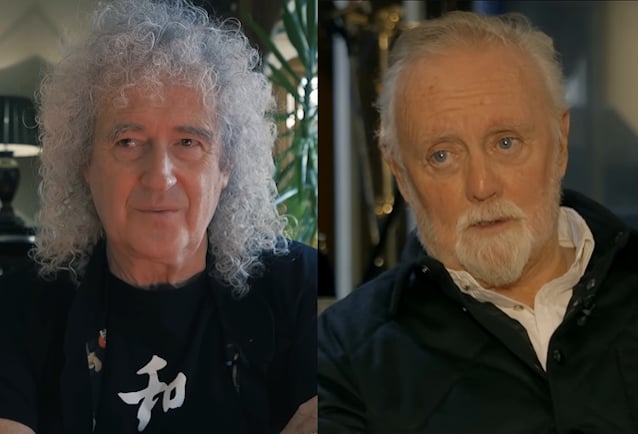QUEEN recently launched “The Greatest Special” video series celebrating “A Night At The Opera” vinyl reissue and 50th anniversary of “Bohemian Rhapsody”.
With QUEEN’s classic 1975 album newly reissued on limited-edition crystal-clear vinyl — and its most famous song celebrating a half-century — guitarist Brian May and drummer Roger Taylor take us behind the scenes in an exclusive video series released throughout November.
Having previously revealed the songs that paved the way for “Bohemian Rhapsody” and “A Night At The Opera” in exclusive new interviews for “Queen The Greatest”, Taylor and May reveal how the technical experiences on the band’s first three albums enabled them to realize their outrageous ambitions for their make-or-break fourth album, “A Night At The Opera”.
For QUEEN, the recording studio was an instrument in its own right. And while the young band were forced to toe the line while creating 1973’s debut album at Trident Studios, their expanding popularity gave them more control on each record — culminating in the unbound experimentation of 1975’s “A Night At The Opera”.
Now, as that classic fourth album celebrates its 50th anniversary with a new celebratory clear-vinyl reissue, this week’s episode of “Queen The Greatest” shares further exclusive new interviews in which May and Taylor recall how the band’s early studio experiences shaped their identity.
“Really, I think ‘Queen II’ was the first time we were allowed a certain amount of freedom in the studio, whereas with the first album we weren’t”, says Taylor , “so basically it sounds better and more like the way we wanted it to sound. I don’t think its perfect by a long way, but we were building our confidence in the studio. It had a lot more light and shade.”
As Brian affirms, the shifting balance of power can be heard in the ambitious soundscapes of 1974’s “Queen II”. “I’ve always been a big advocate of that album because I think it was a giant step,” he says. “We’re going from a band that is hardly allowed in the studio — except a few hours in dead time — to a band that actually has studio time. We can indulge ourselves. We can experiment, and we make a giant leap with painting pictures on the canvas of the tapes on ‘Queen II’. I love that album.”
By contrast, Roger recalls the band largely dialling back the production on third album “Sheer Heart Attack”, released in November 1974. “In general, that was a hard-hitting, more simplified album,” he says. “And, in my opinion, that was to its credit. The songs were good, they weren’t too long, weren’t over-elaborate. It was more stuff we could actually play live without getting too much into studio trickery.”
But as Brian counters, the band’s natural tendency towards the ambitious and grandiose set their course for 1975’s “A Night At The Opera”. “We go complex again,” he remembers of album sessions that at the time were the most ambitious and expensive in history. “You know, let’s pursue our dreams a bit further. We’ve done ‘Sheer Heart Attack’; it’s done quite well. But, really, our heart is in chiseling out these unusual places. In those days, it was fun, because it’s like getting a new car and seeing what you can do with it. It’s the four of us — with Mike Stone, the engineer and Roy Baker, our producer — and we’re all learning how to use the studio. Pushing things ever further.”
While QUEEN’s first three albums made them stars, by 1975, the band were still living in penury, and as Brian recalled, had this fourth album failed, “I think we would have just disappeared under the ocean.” Thankfully, “A Night At The Opera” flew to a U.K. No. 1, and half a century later, the new vinyl reissue presents a record that broke all the rules, its head-spinning material roaming from the seething rock of “Death On Two Legs” to “Seaside Rendezvous” vaudeville whimsy.
“For any song we took on, no matter who amongst the four of us had brought it in, it was an exhilarating process,” remembers Brian, “challenging, sometimes difficult, sometimes argumentative — but really rewarding, because what you got in the end was something so shiny, rounded, adventurous and dangerous. It became QUEEN stuff — and QUEEN stuff was a million times greater than anything that any one of the four of us could come up with on their own…”
The new series “Queen The Greatest” continues weekly throughout November.

